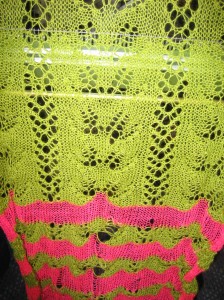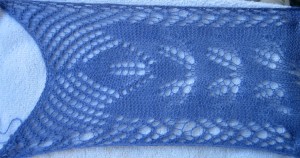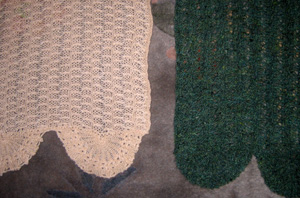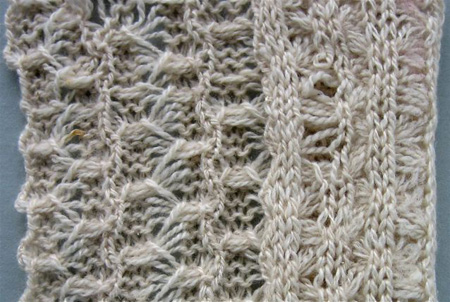This baby blanket was a double bed knit on a Passap machine, inspired by the woven patterns found in early American coverlets. Blue, red, and white are in use. Because of the knitting technique as colors knit one at a time the alternate colors “bleed through”, giving the illusion of more or even different colors.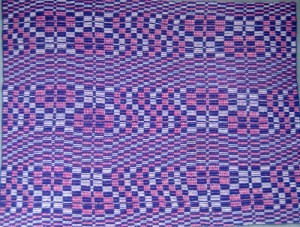
On the blocking board.
After hand washing the piece, blocking wires and pins were used to help it retain desired shape while drying. Its final measurements in inches are 20W by 68L, its weight 3.25 oz. Steaming alone helped stabilize stitches for corrections and is often enough for many pieces in terms of blocking, but flattened the surface excessively in this case. Texture returned and became more apparent with the use of the former method. In the image below the center, pivoting point of the mirrored pattern is evident.
In progress
The first half of the shawl as it appears on the machine in the process of being knit after several false starts. Gaping holes were typical of potential stitch “drops”. Yarn was knit at loose tension for the effect, in turn resulting in gate peg issues at intervals, but tolerated the lace transfers and hook up problems without breaking, an absolute necessity in a piece such as this. Studio brand ribber comb provided the best source of even weight.
Beginnings
MacKnit was a very short lived American machine knitting magazine (1980s). In Number 5, beginning on page 40, Susanna published a lace shawl pattern that included several transfer lace types. Garment shaping was achieved through an intriguing series of triangles joined during the knitting of them. Using her lace graphs, so far I have the resulting swatches below. There are 2 errors I need to sort out; the fabric is intriguing. The top pattern rows become the triangular edging. The yarn that finally “worked” for me was the Valley Yarns 2/14 Alpaca Silk blend from Webs.
The swatches were very quickly steamed. Lace is one of those fabrics that actually require “real” blocking for best results. Some hand-tooling is mixed in the repeats, stitch formation needs to be constantly checked. Will sort out problem areas, then see where that takes me while keeping any first project as simple as possible.
New directions
Winter inventory was completed long ago. I live in the northeast which has had a notoriously snowy winter. Many an hour has been spent in snow removal, few hours knitting anything “new”. I have completed some hand knitting projects, and as one, I attempted re-knitting a lace shawl successfully completed multiple times before. Having trouble tracking its complicated pattern, I journeyed back to taking “another look” at machine knit lace. Multiple transfer lace on the machine can be slow, tedious, and requires patience in the original setup, as one must have yarn that tolerates transfer across fixed metal parts without breaking and the “perfect” weight to allow stitches to knit off properly. Though I like designing my own stitch patterns this is not anything I am ready to do in lace.
The first foray in my explorations resulted from a discussion on a knitting yahoo group I belong to with regards to a lace chart published at redlipstick.net (website was later deleted).
Below are images of the resulting fabric:
purl side  knit side
knit side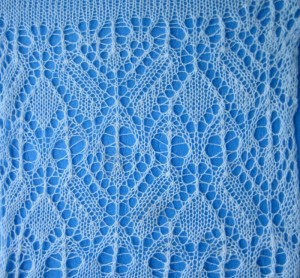
The wonders of blocking
Blocking is one of those knitting preferences that can arouse strong pro/con arguments, and goes the range from casual to nearly compulsive with wires, pins, and assorted tools used to achieve desired results. My shawls continue to sell well: the photos below illustrate part of the process and 2 of the most recent in their family. All shaping and joining are achieved through the knitting process; the shawls are reversible, may be worn and draped in a variety of ways.
before steaming and pressing
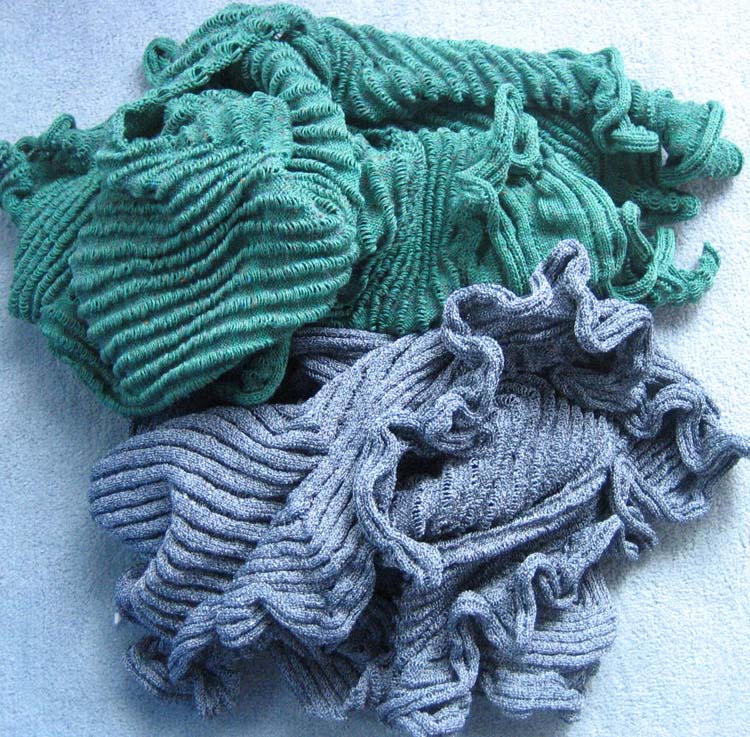
detail shot after steaming/pressing
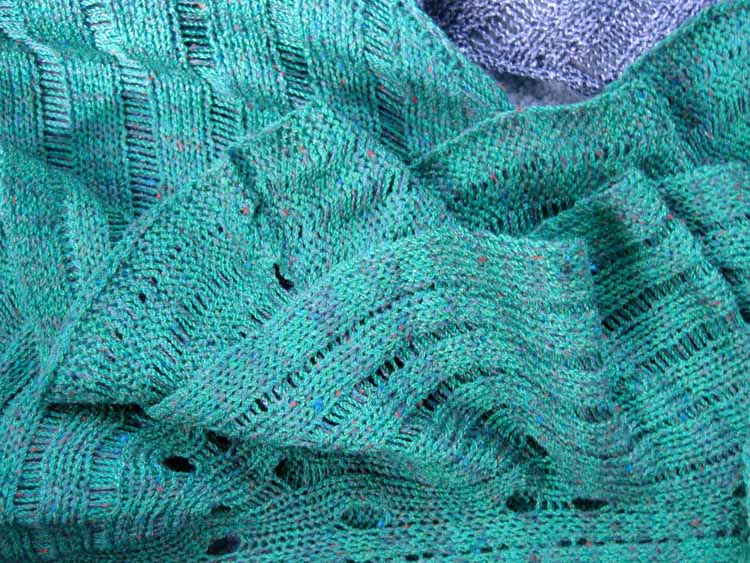
one way to wear, purl side facing out

Getting seasonal: “happy hollow”
My first “fiesta” ornament with some mood lighting (frame is actually bright embossed aluminum), 4.25-inch square
Two of the triplets
To block or not to block
Pattern repeats are sorted out, out of work needles correct positions critical, many false starts, then onto yarn crankiness. Two “shawls” are now knit, approximately 16 inches by 64 inches, one in off-white cashmere, the other in over spun wool. They are large enough to drape around shoulders, lightweight enough to wrap for warmth as scarves. Both required washing to remove sizing, are now very different in body and touch. My favorite way to “block” laundered items is air drying on a wool rug after a couple of spin cycles in the washer. I use pressing/steaming if appropriate to fiber, do have blocking wires, but they have only ever seen daylight as substitutes if I “lose” ribber cast on comb wires. Next in this family will be a shot at knitting this item with a thin ribbon. Here is the completed drying twosome with their purl side public face. The Knit side is interesting as well, duplicating the hand technique swatch exactly. Yarn weights used are pushing boundaries for KM, knitting is extremely slow after design/yarn problems are all sorted out. Though this online post follows camera documentation that began yesterday, the actual process has occurred over the past 2 weeks.
A shawl tale
I have always been interested in mock crochet stitches executed on the knitting machine, have done a bit of experimenting in the past. The ones that are the most interesting to my eye are usually knit on the double bed, often making them reversible, which in turn may require hand manipulations. Browsing through old knitting magazines I came across this baby sweater and became determined to produce a similar fabric, in a manner that might be more manageable for production. In this instance the back locks are changed in sequences of 3, 1, with button changes, the yarn is fine. The first sample I produced was following the pattern stitch instructions.

The fabric as a hand technique, dropped stitches included
The challenge: creating a downloadable stitch pattern that will automatically select appropriate needles and duplicate this texture. Yarn used will be varied and have different weights. Pusher/needle set up both beds critical, then there must be an edging…more to follow.

